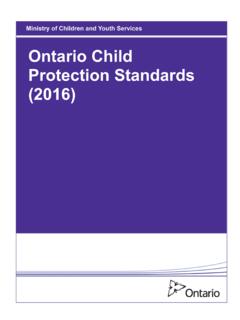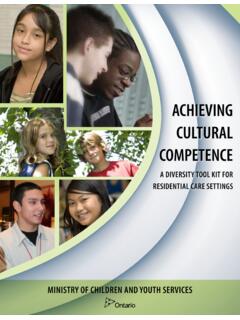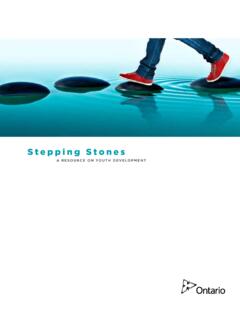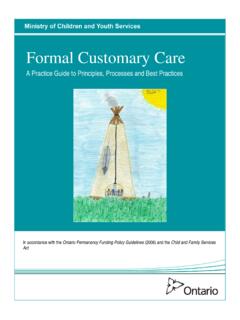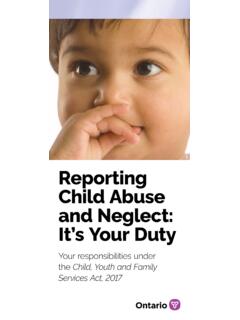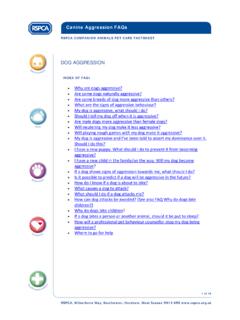Transcription of Achieving Cultural Competence - Ministry of Children ...
1 Achieving . Cultural . Competence . A DIVERSITY TOOL KIT FOR. RESIDENTIAL CARE SETTINGS. Ministry OF Children AND YOUTH SERVICES. This tool kit was prepared exclusively for the Ministry of Children and Youth Services by Ruby Lam and Bernice Cipparrone, Diversity Specialists. While the Ministry has attempted to verify the accuracy of the information contained in this tool kit, users should not rely solely on this information to make decisions regarding Children and youth in residential care. The content of the tool kit is provided by the Ministry of Children and Youth Services for informational purposes only and should not be taken as advice or recommendations for any particular decision regarding a child or youth in residential care.
2 Use of the tool kit is voluntary. There are web sites linked to and from this tool kit that are operated or created by or for organizations outside of the Government of Ontario. Those organizations are solely responsible for the operation and information (including the right to display such information) found on their respective web sites. These linked web sites may or may not be available in French. The linking to or from this site does not imply on the part of the Government of Ontario any endorsement or guarantee of any of the organizations or information (including the right to display such information) found on their respective web sites.
3 The Government of Ontario does not assume and is not responsible for any liability whatsoever for the linking of any of these linked web sites, the operation or content (including the right to display such information) of any of the linked web sites, nor for any of the information, interpretation, comments or opinions expressed in any of the linked web sites. Any comments or inquiries regarding the linked web sites are to be directed to the particular organization for whom the particular web site is being operated.
4 1. TABLE OF CONTENTS. FOREWORD. A. COMMON MISCONCEPTIONS ABOUT DIVERSITY ISSUES. B. THE CASE FOR DIVERSITY. Benefits of Becoming Culturally Competent Responding to the Diversity Within Ontario Impact of Health and Social Disparities The Legal Framework for Diversity What is Discrimination? Anti-Oppression Policies C. STANDARDS. Guiding Principles of Diversity Organizational Change The Gold Standard D. GETTING STARTED. Getting Started: A 10-Point Plan Tips for Staff and Foster Parents on Becoming Culturally Competent E.
5 Achieving CULTUR AL Competence IN RESIDENTIAL SERVICES: AN ORGANIZATIONAL SELF-ASSESSMENT TOOL. F. LOCAL DIVERSITY INITIATIVES. William W. Creighton Youth Services (Thunder Bay). Pioneer Youth Services (Waterloo). Children 's Aid Society of Toronto (Toronto). Kinark Syl Apps Youth Centre (Oakville). Bayfield Homes Eagle Rock Lodge Program (Consecon). YOUTHLINK (Toronto). G. ADDITIONAL RESOURCES. Glossary of Diversity Terms Bilingual Diversity Websites Books and Articles Bilingual Community Networks for Equity-Seeking Groups Children 's Bills of Rights Sample Board Policy Statements on Diversity Holy Days and Holidays 2.
6 FOREWORD. The purpose of this tool kit is to inspire courageous discussions about difficult issues, thus opening the way to positive change. Diversity organizational change: big words. But at the heart of it, diversity organizational change is about creating environments that respect differences in our society, where there is no one on the outside looking in, where all Children and youth feel safe, and where we all belong. Diversity refers to the range of differences among people. We are all diverse.
7 We all belong to different groups and cultures. Our identities may be defined by our race, ethnicity, age, gender, sexual orientation, religion, language, physical or mental abilities, educational background, socio-economic status, rural or urban residence, as well as other factors. There is nothing inherently good or bad about difference; it is what we make of it. With the right leadership and in the right environment differences can enrich our lives. Without that leadership, differences can be used to exclude and to cast people to the margins of society.
8 The cost of exclusion is that Children and youth who feel socially isolated or emotionally upset are less likely to be able to learn and achieve to their full potential, in school or in life. Children and youth in residential care come from a variety of backgrounds and have a multitude of needs. This tool kit guides staff in creating residential care settings* that are competent in serving a culturally diverse range of Children and youth. It is a primer that establishes basic concepts related to diversity: What is Cultural competency and why is it important?
9 What is discrimination and how do I recognize it? How do I bring about diversity organizational change? The tool kit is also written as a how-to' guide on assessing your organization's level of Cultural Competence and initiating concrete change. Ontario is a vibrant mix of people with a wealth of talents to offer. But such a vibrant group has a variety of needs, some based on diverse Cultural identity. Whatever our particular identity, we all want to feel welcome, understood, accepted, and safe. We all deserve to be included and to have our needs met.
10 It is our hope that this tool kit helps your organization make equity and inclusion a reality for all the Children and youth that you serve. We wish you great success on your diversity journey. Ruby Lam and Bernice Cipparrone February 2008. * Licensed residential care settings include group homes, foster homes, provincially operated facilities, youth justice open and secure custody/detention facilities, and secure youth justice units in facilities shared with adults. 3. SECTION A. COMMON MISCONCEPTIONS ABOUT DIVERSITY ISSUES.
